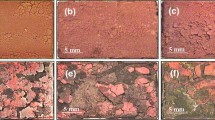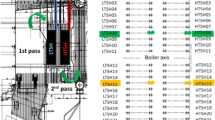Abstract
Superheater and reheater tubing constitute very critical parts of the boilers operating in advanced ultra-supercritical (A-USC) power plants. They are subjected to severe hot corrosion conditions during operation. The operating temperature and pressure in these power plants are very arduous, and materials with high resistance to hot corrosion and creep are required to produce the said tubing. Increased use of superalloys comes into picture in A-USC power plants, because of the demanding operating conditions prevailing there. Inconel 617 has been a superalloy developed for use in the form of superheater and reheater tubing seen in the power plants operating in A-USC environments. There have been researches aiming at improving its creep resistance, and versions with optimum chemical composition have been developed. Alloy 617 OCC, an optimized version of the superalloy 617, has been produced as a candidate material for superheater and reheater tube manufacturing in the context of development of A-USC power plant technology in India. However, hot corrosion issues are equally important for such applications. In light of the foregoing, studies have been carried out to analyse the performance of Alloy 617 OCC in hot corrosion conditions in simulated A-USC power plant environments. Oxidation tests for the alloy were conducted in the laboratory air environment under identical temperature/time conditions for the sake of comparison. Hot corrosion process was examined using thermo-gravimetry, and the corrosion products were characterized using a variety of material characterization techniques. The study reported the comparative corrosion performance of the superalloy in the two environments.
Similar content being viewed by others
Explore related subjects
Discover the latest articles, news and stories from top researchers in related subjects.Avoid common mistakes on your manuscript.
1 Introduction
For achieving an increment in the energy conversion efficiency of the modern power plants, they must be operated at temperatures in the range of 700–720 °C. In addition, the steam pressures within the boilers and tubing should be kept up to 393 bar [1]. Deterioration by hot corrosion is one of the issues extensively experienced for the superheater and reheater tubing integrated with boilers functioning in A-USC power plant environments [2,3,4]. The currently used power plant materials are not adequate enough to withstand the higher pressures and temperatures for long service periods, as they are designed for functioning at pressures up to 250 bar and temperatures up to 600 °C [5, 6]. Alloy 617, a Ni-based superalloy, with high Cr content for an enhanced corrosion resistance was identified in this regard. Mo and Co present at a significantly high level in the alloy also contributed in enhancing its mechanical properties at high temperatures [7]. Hot corrosion performance of Alloy 617 OCC was researched here, in a laboratory-simulated environment comprising of synthetic coal ash and flue gas at 700 °C. Oxidation test at 700 °C was also conducted in the laboratory air environment for a comparative study. The compositions of the simulated coal ash and flue gas mixtures used in this study were the same or very similar to those adopted by earlier researchers to analyse the hot corrosion performance of INCONEL 617 and 740 to simulate USC power plant environments [8, 9].
2 Materials and Methods
Alloy 617 OCC was procured as hot-rolled plate of dimensions 16 mm × 175 mm × 200 mm, and it had the chemical composition (in wt%) as follows: Ni-55.20, Cr-22.56, Co-10.32, Mo-8.75, Al-0.95, Fe-1.18, C-0.068, Mn-0.026, Si-0.08, S-0.001, Ti-0.413, Cu-0.003, B-0.001.
The alloy plate was cut into specimens of 25 mm × 16 mm × 5 mm in dimension. Surfaces of the specimens were mirror-polished up to a grit size of 1000 and thoroughly washed with acetone. The experimentation was carried out as two sets: (i) hot corrosion in the (salt + gas) environment and (ii) oxidation in the air environment. The (salt + gas) environment was simulated by using the specimens along with a slurry comprising of Na2SO4 (5%) + K2SO4 (5%) + Al2O3 (30%) + Fe2O3 (30%) + SiO2 (30%) (Figures in wt%). The coated samples were exposed at 700 °C to a flowing gas mixture containing CO2 (15%), O2 (3.5%), SO2 (0.25%) and the rest N2 (Figures in vol%). For the air environment test, the samples were exposed to the laboratory air environment at 700 °C. The total exposure time was 5000 h, which was divided into 10 cycles comprising of 500 h each. Hot corrosion kinetics was monitored using thermo-gravimetric analysis. Characterization of the exposed samples was done by SEM, EDS and XRD.
3 Results and Discussion
The weight change graph obtained for the specimens exposed to the air and (salt + gas) environment at 700 °C for 10 cycles (500 h each) is displayed in Fig. 1.
A significant change in weight is not observed in the air environment; in contrast, a substantial weight gain is noticed in the (salt + gas) environment. The weight gain occurring in the (salt + gas) environment is expressed with respect to an initiation phase covering the initial 500 h of exposure followed by a propagation phase with an exposure of 500–5000 h. The initiation period of the (salt + gas) environment, spanning over the initial 500 h (Fig. 1), is relatively short and this makes the alloy 617 OCC inadequate for its usage in the USC power plant environments.
The XRD result obtained after exposing the alloy sample in the air environment for 5000 h (Fig. 2) shows the existence of Cr2O3 phase at the surface of the alloy other than the substrate material peaks. The elemental X-ray mapping result for the sample cross section after this exposure time indicates the presence of a continuous scale layer backed by a Cr-depleted region above the substrate (Fig. 3). Chromium and oxygen are observed in high intensity in the scale layer, indicating the presence of a continuous Cr2O3 layer at the alloy surface. This is believed to be a consequence of the migration of Cr ions from the base metal region towards the alloy surface. Cr2O3 is observed as the only phase in the reaction product over 500 to 5000 h of exposure.
The XRD pattern obtained for the sample exposed for 5000 h at 700 °C in (salt + gas) environment provides evidence for the presence of Cr2O3 in the scale layer. In addition to Cr2O3, several other phases (i) oxide phases NiO, CoO and Al2O3, (ii) spinel oxides CoCr2O4 and FeCr2O4 and (iii) sulphur-containing phases Cr2 (SO4)3 and CrS are seen in the corrosion product developed at the alloy surface (Fig. 2). Figure 4 shows the corresponding cross-sectional X-ray mapping results. While there is a problem of overlapping of spectral lines of Mo and S, it can be stated that Mo and/or S are present in the scale layer. Presence of none of these elements is there in the case of air oxidation. It is thus seen that one or both of these elements contribute to the accelerated degradation process noticed in the (salt + gas) environment. The damaging effect of sulphur-containing species has been reported by Hari et al. [2]. Molybdenum also accelerates the corrosion process and is documented in the literature [10]. It is thus believed that both these elements contribute to the severe hot corrosion experienced in (salt + gas) environment. The presence of high level of Mo in alloy 617 OCC can be a definite disadvantage in this respect.
4 Conclusions
Hot corrosion performance of alloy 617 OCC was studied in USC power plant environment simulated in the laboratory. For the sake of comparison, oxidation of the alloy was studied in the air environment, with the exposure temperature and time remaining the same. The following conclusions were reached.
-
There was no significant change in weight in the air environment tests. In contrast, substantial weight gain was detected in the (salt + gas) environment tests and the weight gain was increasing monotonically with exposure time.
-
The scale layer contained significant levels of Mo and/or S in case of samples corroded in (salt + gas) environment. It was concluded that Mo present in the alloy and sulphur-containing species in the flue gas environment played active role and had major contribution to the high rate of corrosion observed in this environment.
References
Viswanathan R, Advances in Materials Technology for Fossil Power Plants, ASM International, Florida, USA (2008).
Hari P R, Arivazhagan N, Rao M N, and Pavan AHV, Trans Ind Inst Met 9 (2017) 775.
Alcock C B, Hocking M G, and Zador S, Corros Sci 9 (1969) 111.
Sivakumar R, Sagar P K, and Bhatia M L, Oxid Met 24 (1985) 315.
Bugge J, Kjaer S, and Blum R, Energy 31 (2006) 1437.
Ennis P J, and Czyrska-Filemonowicz A, Sadhana 28 (2003) 709.
Yeh T K, Chang H P, Wang M Y, Yuan T, and Kai J J, Nucl Eng Des 271 (2014) 257.
Zhao S, Xie X, Smith G D, and Patel S J, Mater Chem Phys 90 (2005) 275.
Aung N N, and Liu X, Corros Sci 82 (2014) 227.
Patel S J, Baker B A, Gollihue R D, Procedia Engineering 55 (2013) 246.
Acknowledgements
The authors are immensely grateful to the Department of Science and Technology and the Science and Engineering Research Board for the funding and support. We wish to express our deep gratitude to the BHEL (Bharat Heavy Electricals) Hyderabad for supplying the superalloy.
Funding
Funding was provided by Science and Engineering Research Board (IN) (Grant No. SB/S3/ME/35/2013).
Author information
Authors and Affiliations
Corresponding author
Additional information
Publisher's Note
Springer Nature remains neutral with regard to jurisdictional claims in published maps and institutional affiliations.
Rights and permissions
About this article
Cite this article
Hari, P.R., Arivazhagan, N., Nageswara Rao, M. et al. Behaviour of Alloy 617 OCC Under Hot Corrosion Conditions Encountered in Boilers in A-USC Power Plants. Trans Indian Inst Met 72, 1511–1514 (2019). https://doi.org/10.1007/s12666-018-1543-1
Received:
Accepted:
Published:
Issue Date:
DOI: https://doi.org/10.1007/s12666-018-1543-1








